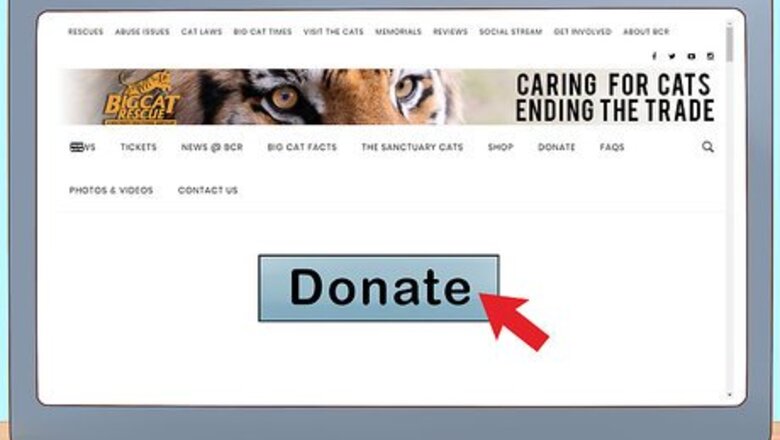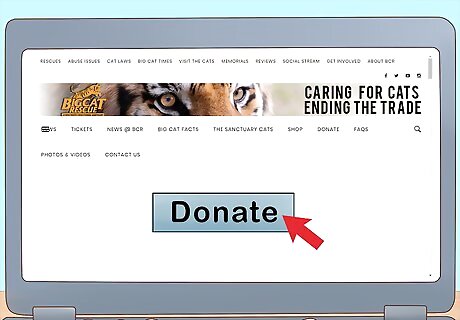
views
Getting Involved

Donate to a tiger research fund. The easiest way to join the effort to save tigers is to donate your money to the various organizations dedicated to saving wildlife. There are many organizations out there, so it is really important to do your homework before you choose one to donate to. Some organizations that have their own tiger programs include: Panthera (United with the Save the Tigers Fund) World Wildlife Fund Smithsonian Tiger Conservation Fund International Fund for Animal Welfare Big Cat Rescue National Tiger Sanctuary Sadly, there are plenty of scams out there that take advantage of the plight of the tigers. You can choose a one time donation or a monthly donation.

Adopt a tiger. The World Wildlife Fund (WWF) offers an adopt a tiger program. You can symbolically adopt a tiger and help fund the work the WWF is doing with your adoption donation. There are different adoption packages available, ranging from $55 to $250. Your money will go towards creating reserves for tigers, protection from poachers, and other WWF conservation work. In addition to knowing that you are helping this special creature, you also receive a photo and information card of the tiger you are helping to save, along with a plush version of your tiger.

Visit zoos accredited by the Association of Zoos and Aquariums. Some zoos participate in Species Survival Plans, which are sanctioned breeding plans to help save tigers. Only visit zoos that are accredited by the AZA. There are currently 223 zoos and aquariums around the world that meet the AZA’s strict requirements. For a list of accredited zoos and aquariums that you can visit or donate to, visit the Association of Zoos and Aquariums website. These zoos keep their animals, including their tigers, in excellent living conditions, and are doing what they can to support the healthy breeding of animals on the endangered list. You can also visit wildlife sanctuaries that do not let visitors handle their animals and do not participate in breeding. There are also wildlife rehabilitators, universities working on establishing wild animals, and some traveling circuses that meet all of the requirements of the Animal Welfare Act. If you are not sure of the status of a zoo or wildlife area you are hoping to visit, run an internet search on the institution.

Volunteer at a tiger sanctuary. There are many sanctuaries and reserves that accept volunteers and interns around the world. These volunteers help maintain the grounds, observe the animals, and perform other various chores and tasks. In some places, volunteers can lead tours of the grounds and talk about the tigers with visitors. You can run an internet search to explore options near you. Some of the most prominent sanctuaries that accept volunteers include the National Tiger Sanctuary and Big Cat Rescue. You can also try a GoEco program.

Travel to a tiger reserve. Tiger reserves are large plots of the tigers’ native land that has been specifically designated for the tigers. Of course, visiting a tiger reserve means flying to places like India or Nepal. If you have the ability to do so, then while you are there you should join a tour operated by the park service of the country. They rely on the income from tourism to help pay for part of their expenses. Tourism also brings money to the area where the reserve is located, which in turn inspires support for the reserve from the local community. Do some research on the tour company before you fly off to visit the tiger reserve or national park.
Raising Awareness

Attend fundraising events for tiger and wildlife organizations. Organizations put on fundraising events to help garner support and money for their efforts in protecting the tiger and other wildlife. You can participate, or even help run, these events in your area. Run an internet search to find out if there are any events happening in your area.

Support legislation for survival of tigers. In the United States, write to your U.S. Representative, asking them to support the Big Cats and Public Safety Protection Act (H.R. 1998/S. 1381). Organizations dedicated to the preservation and rightful treatment of big cats have called on Congress to pass the Big Cats and Public Safety Protection Act (H.R. 1998/S. 1381). The Act calls for: An amendment to the Captive Wildlife Safety Act, effectively ending the private breeding of big cats like tigers, as well as lions, leopards, and cheetahs. It is estimated that over 10,000 big cats are kept in bad conditions throughout the United States. Penalties for violators of the Act. If someone is abusing or badly mistreating their animals, the Act calls for up to $20,000 in fines and a jail sentence of up to five years, during which time the animals would be confiscated and rehabilitated. There is an online letter that you can send to your representative. You will find this drafted letter here.

Sign petitions to save tigers and wildlife. Another way you can get involved is to sign petitions covering various aspects of tiger conservation. Petitions cover stopping the tiger trade, preventing deforestation, and ending the sale of tiger products. You can find petitions through petition websites like change.org and tiger conservation websites.

Stay informed about tigers and conservation issues. The best way to keep on top of the news regarding the work being done to help save tigers is by signing up for newsletters through various wildlife, and specifically tiger, protection organizations. These emails will update you on the new challenges being faced, the steps being taken to help, and the victories being won.

Spread awareness about tigers and conservation through social media. Encourage others to support the efforts being made to save the tigers. Social media is a very handy tool for this. Post links to interesting articles about the plight of the tigers and spread word about petitions that your friends and family can sign. You can also follow your favorite tiger organizations on Facebook, Twitter, or any of the other various platforms out there.
Buying Tiger-Friendly Products

Buy products from sustainable companies. One of the major reasons tigers are endangered is because their home is being destroyed. Illegal logging and forest clearing are destroying the habitat that tigers live in, causing them to become displaced without enough food or land to sustain themselves. One way that you can help is by purchasing your goods from companies that only implement sustainable practices. You can also purchase 100% post-consumer recycled paper. Look for paper and wood products that are approved by the international Forest Stewardship Council (FSC). The goal of the FSC is to improve forest practices and therefore end deforestation, around the world.

Buy sustainable palm oil. Palm oil is a popular vegetable oil used in food and cosmetics. The palm oil industry has led to deforestation and the destruction of tiger habitats. Only buy products that use palm oil from a sustainable source. Look for products with the Roundtable on Sustainable Palm Oil (RSPO) trademark.

Buy sustainable coffee. One major source of deforestation comes from the coffee industry. The next time you are purchasing some java, look for a brand that is sustainable. This means that they do not condone the practice of deforestation. Sustainable brands will have a certification on the box from an independent certifier, like Fair Trade, Rainforest Alliance, or UTZ Certified.

Avoid purchasing tiger products. Poaching is the number one threat to tigers. Never buy tiger products, either in your own country or while traveling abroad. This includes products made with tiger parts or tiger derivatives. Do not buy any traditional medicine that is made from tiger parts, such as tiger bone. Today some chemists still use tiger bone, even though it is illegal and the main part of the reason tigers are endangered. Poachers hunt these beautiful creatures illegally, so much so that there are now only an estimated 3,200 tigers left in the wild.


















Comments
0 comment